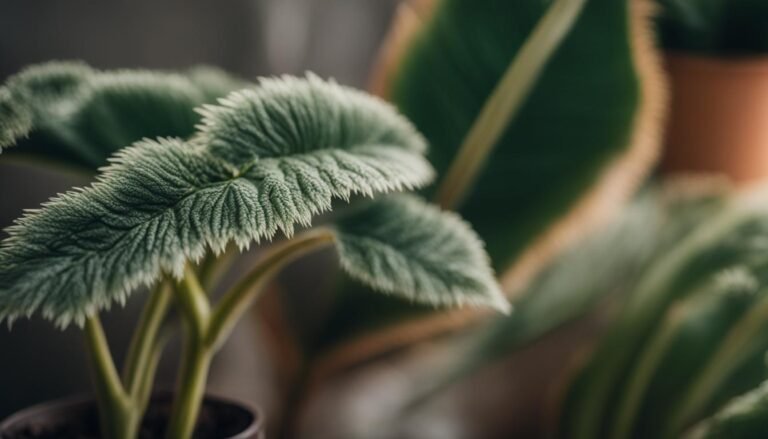Once upon a time, I walked into a friend’s house and was immediately captivated by the lush greenery that adorned their living room. One particular plant caught my eye – it had an enchanting velvety texture that was irresistible to touch. Its fuzzy leaves added a cozy and inviting feel to the space, creating a serene ambiance that was hard to replicate.
Curiosity piqued, I inquired about this mysterious houseplant, eager to bring the same velvety charm into my own home. My friend proudly introduced me to the world of houseplants with fuzzy leaves, showcasing different varieties that ranged from small and compact to large and statement-making. As they shared their knowledge and care tips, I couldn’t help but fall in love with these unique plants, each possessing its own alluring qualities.
Since that day, my collection of houseplants with fuzzy leaves has grown, transforming my living space into a serene oasis. Not only do these plants add beauty and visual interest, but they also provide a comforting presence, creating a sense of tranquility in my home. Now, I can’t imagine my living space without the soft and velvety touch of these delightful houseplants.
In this comprehensive guide, I will introduce you to a variety of houseplants with fuzzy leaves, helping you discover the perfect additions to your indoor sanctuary. Get ready to unlock the velvety charm and transform your living space into a cozy haven!
Key Takeaways:
- Houseplants with fuzzy leaves add texture and allure to indoor spaces.
- There are numerous types of houseplants with fuzzy leaves, each with its unique characteristics.
- Small houseplants with fuzzy leaves are perfect for compact spaces with low light.
- Popular houseplants with fuzzy leaves include Echeveria harmsii ‘Ruby Slippers’ and Kalanchoe tomentosa ‘Chocolate Soldier’.
- Identifying your houseplant is important for providing proper care and ensuring its healthy growth.
Types of Fuzzy Plants
There are several types of houseplants with textured leaves, commonly known as foliage plants, that can add a unique touch to your indoor space. These plants not only bring a sense of visual interest but also provide a delightful tactile experience with their soft and velvety foliage.
Here are some popular examples of houseplants with textured leaves:
- Senecio haworthii – Woolly Senecio: This plant features elongated leaves covered in fine, silvery hairs, giving it a woolly appearance. The texture of the leaves adds depth and dimension to its overall aesthetic.
- Crassula rogersii: Also known as the Baby Necklace plant, this succulent showcases slender, cylindrical leaves covered in tiny hairs. The fuzzy texture of the leaves creates an intriguing contrast against its sleek and compact growth habit.
- Sempervivum ‘Jade Rose’: This rosette-shaped succulent has plump, fleshy leaves that appear covered in a delicate layer of fine hairs. The velvety feel of the foliage adds a captivating charm to its distinctive appearance.
These houseplants with textured leaves are perfect for introducing a touch of nature’s diversity into your indoor oasis. Their soft and fuzzy foliage enhances the visual appeal of any space, providing a unique sensory experience for plant enthusiasts.
“The soft and velvety texture of these plants’ leaves adds a delightful tactile experience to their visual allure.”
Small Houseplant with Fuzzy Leaves List
If you’re looking for small houseplants with fuzzy leaves, there are plenty of options to choose from. Some popular choices include Cotyledon tomentosa – Bear’s Paw, Echeveria setosa var. minor, and Plectranthus tomentosa – Vicks Plant. These plants are not only compact in size but also thrive in low-light conditions, making them perfect for small indoor spaces.
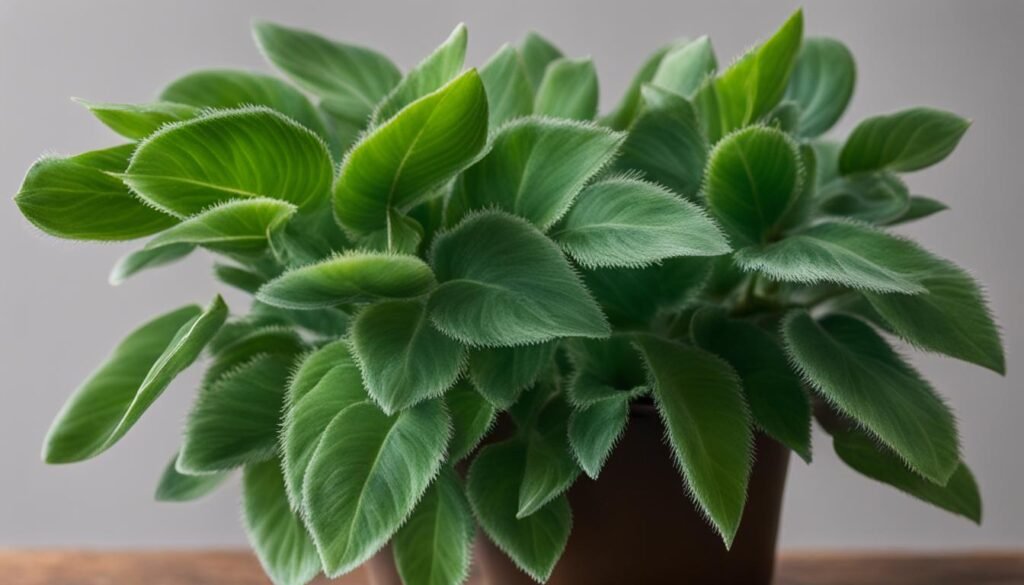
| Plant Name | Description | Light Requirement |
|---|---|---|
| Cotyledon tomentosa – Bear’s Paw | Fragile leaves resembling bear paws | Low to medium light |
| Echeveria setosa var. minor | Densely packed leaves with a velvety texture | Low to bright indirect light |
| Plectranthus tomentosa – Vicks Plant | Soft, mint-scented leaves | Low to medium light |
“These small houseplants with fuzzy leaves bring a touch of coziness and charm to any indoor space.” – Jane Thompson, Indoor Plant Enthusiast
What House Plant has Fuzzy Leaves?
Many houseplants have fuzzy leaves, adding a unique and tactile appeal to their appearance. Some examples of popular houseplants with soft and fuzzy foliage include:
| Houseplant | Scientific Name |
|---|---|
| Echeveria harmsii ‘Ruby Slippers’ | Echeveria harmsii ‘Ruby Slippers’ |
| Kalanchoe tomentosa ‘Chocolate Soldier’ | Kalanchoe tomentosa ‘Chocolate Soldier’ |
| Mammillaria bocasana – Powder Puff Cactus | Mammillaria bocasana |
These popular houseplants are beloved by plant enthusiasts for their soft and fuzzy foliage. They not only add visual interest to your indoor space but also provide a delightful tactile experience for those who touch them.
One such example is the Echeveria harmsii ‘Ruby Slippers’, which features rosettes of velvety, green leaves with reddish edges. Its fuzzy texture invites you to run your fingers over the soft foliage, making it a joy to behold.
“Houseplants with fuzzy leaves bring a unique tactile experience to your indoor space. Their soft, velvety texture adds a cozy touch and invites you to engage with nature on a whole new level.”
Whether it’s the fuzzy leaves of the Kalanchoe tomentosa ‘Chocolate Soldier’ resembling chocolate drops or the fluffy spines of the Mammillaria bocasana – Powder Puff Cactus, these houseplants offer both visual and tactile delight.
With their plush foliage, these houseplants invite you to create an indoor oasis filled with warmth, texture, and natural beauty.
How do I Find out What Houseplant I Have?
If you’re unsure about the specific houseplant you have, there are several resources available to help you identify it. Identifying your houseplant is essential for providing the proper care and ensuring its healthy growth. Here are a few methods you can use to determine the exact species of your plant:
1. Plant Identification Apps
Plant identification apps have become increasingly popular and convenient. You can simply take a photo of your houseplant and use the app to match it with its database of known species. Some popular plant identification apps include PlantSnap, PictureThis, and Planta.
2. Online Forums and Communities
Engaging with online communities and forums dedicated to houseplants is another effective way to identify your plant. You can post a clear photo of your houseplant and ask for help from experienced plant enthusiasts who may recognize the species based on their knowledge and experience.
3. Local Plant Nursery
If you prefer a more hands-on approach, you can visit a local plant nursery or garden center. Bring a sample or clear photos of your houseplant and consult the experts there. They have extensive knowledge of different plant varieties and can help you identify your specific plant.
By utilizing these resources, you can confidently identify your houseplant and access relevant information about its care and maintenance. Remember, knowing the specific species of your plant is crucial for providing it with the right conditions and ensuring its well-being.
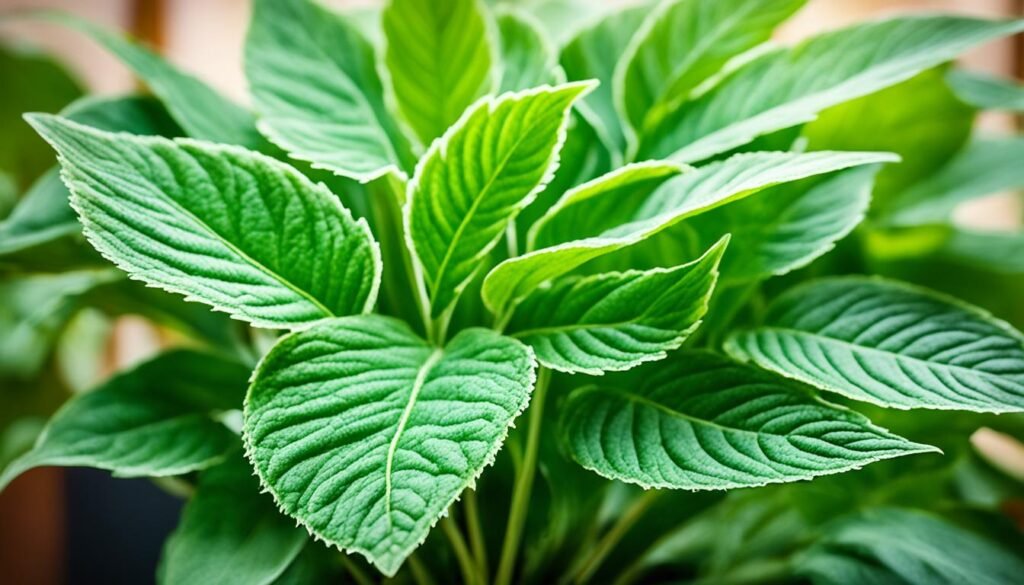
| Plant Identification Methods | Pros | Cons |
|---|---|---|
| Plant Identification Apps | – Convenient and easy to use – Offers instant results – Access to extensive plant databases | – Some apps may require a subscription – Accuracy may vary depending on app and image quality |
| Online Forums and Communities | – Community input and expertise – Free access to collective knowledge – Personalized assistance | – May take time to receive responses – Relies on community expertise |
| Local Plant Nursery | – Expert advice and guidance – Physical interaction with plants – Ability to examine plant characteristics in person | – Requires visiting a physical location – Limited to local expertise |
What Houseplant has Fuzzy Leaves and Stems?
While many houseplants have fuzzy leaves, some also have fuzzy stems. One example is Cotyledon tomentosa – Variegated Bear’s Paw. This plant not only has soft, velvety leaves but also features fuzzy stems, adding an extra dimension of texture to its appearance.
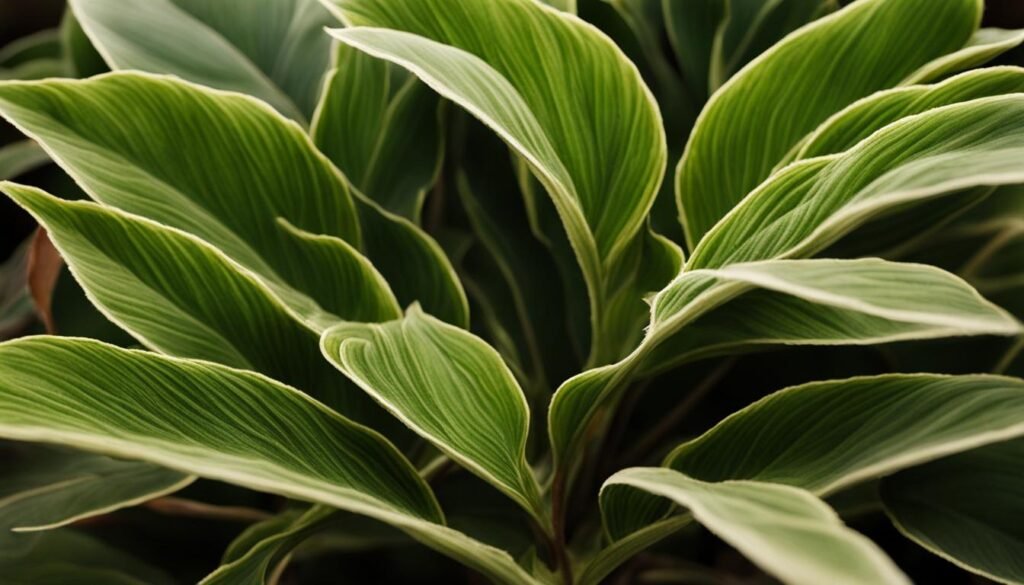
This beautiful houseplant showcases its unique combination of fuzzy leaves and stems, creating a visual spectacle that is sure to capture attention. The textured foliage and soft stems lend a delicate charm to any indoor space.
What is a Purple Houseplant with Fuzzy Leaves?
If you’re looking to add a touch of color and texture to your indoor space, a purple houseplant with fuzzy leaves is the perfect choice. These tropical houseplants not only bring a burst of vibrant purple foliage but also feature soft and fuzzy leaves that create a stunning visual display. Let me introduce you to some popular options:
Sempervivum ‘Lemon Babies’
If you’re searching for a distinctive purple houseplant, look no further than Sempervivum ‘Lemon Babies’. This succulent variety showcases rosettes of purple leaves with green tips, giving it a unique and eye-catching appearance. The fuzzy texture adds an extra layer of charm to this small but captivating plant.
Senecio scaposus
Another excellent choice is Senecio scaposus, also known as the purple spearhead. This tropical houseplant features long, arching stems adorned with thick, fuzzy leaves in shades of purple. Its cascading growth habit makes it a perfect candidate for hanging baskets or as a trailing accent in your indoor garden.
Echeveria setosa
Echeveria setosa is a stunning purple succulent that deserves a place in any plant collection. Its rosettes are composed of densely packed, fuzzy leaves in varying shades of purple and green. This low-maintenance houseplant adds a touch of whimsy and elegance to any space.
These purple houseplants with fuzzy leaves not only bring color and visual interest to your indoor oasis but also require minimal care, making them perfect for both beginner and experienced plant enthusiasts.
To help you choose the right plant for your space, here’s a comparison table summarizing the key features of each purple houseplant:
| Houseplant | Main Features | Growth Habit | Light Requirements | Care Level |
|---|---|---|---|---|
| Sempervivum ‘Lemon Babies’ | Purple rosettes with green tips, fuzzy leaves | Compact, clustering | Bright indirect light | Low |
| Senecio scaposus | Arching stems, fuzzy purple leaves | Cascading | Bright indirect light | Low |
| Echeveria setosa | Dense rosettes, fuzzy purple and green leaves | Compact, branching | Bright indirect light | Low |
Choose the purple houseplant with fuzzy leaves that captures your heart and enjoy the beauty and texture it brings to your home.
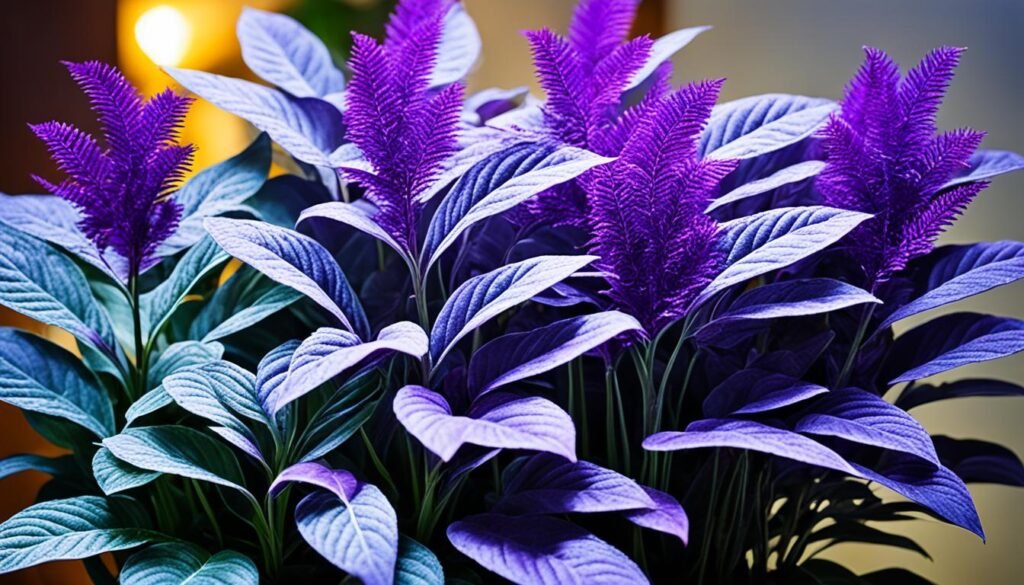
15 Popular Houseplants with Soft Fuzzy Leaves
If you’re in search of popular houseplants with soft, fuzzy leaves, look no further. Here is a list of 15 popular options to choose from:
- African Violet (Saintpaulia)
- Bunny Ear Cactus (Opuntia microdasys)
- Chenille Plant (Acalypha hispida)
- Lamb’s Ear (Stachys byzantina)
- Polka Dot Plant (Hypoestes phyllostachya)
- Purple Passion Plant (Gynura aurantiaca)
- Rabbit’s Foot Fern (Davallia fejeensis)
- Silver Bush (Calocephalus brownii)
- Silver Satin Pothos (Scindapsus pictus)
- Spiderwort (Tradescantia zebrina)
- Teddy Bear Vine (Cyanotis somaliensis)
- Trailing Velvet Plant (Gynura sarmentosa)
- Velvet Calathea (Calathea rufibarba)
- Velvet Plant (Gynura aurantiaca)
- Woolly Lipfern (Cheilanthes lanosa)
These plants are not only visually appealing but also have soft and fuzzy leaves that add a touch of coziness to any indoor space.
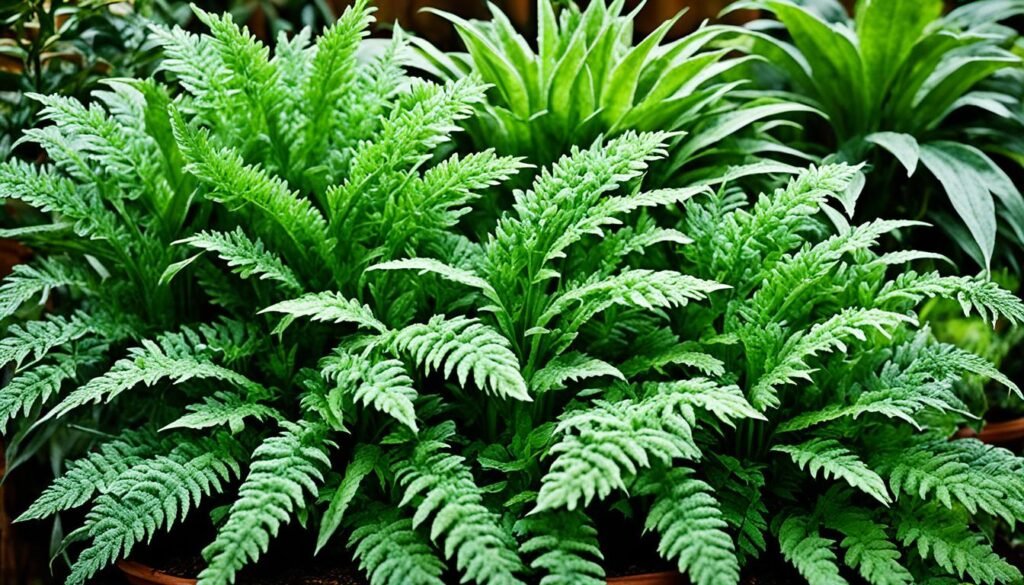
Conclusion
Summing up, houseplants with fuzzy leaves are a delightful choice for adding texture and visual interest to any indoor space. Whether you prefer small houseplants with fuzzy leaves, popular varieties with soft foliage, or tropical plants with velvety textures, these green wonders will bring beauty and tranquility to your indoor oasis.
To ensure the longevity of these velvety wonders, it’s essential to provide proper care. Here are some tips to keep your houseplants with fuzzy leaves thriving:
- Watering: Check the moisture level of the soil regularly and water accordingly. Avoid overwatering as it can lead to root rot, but make sure not to let the soil dry out completely.
- Light: Understand the light requirements of your specific houseplant and place it in an appropriate location. Some prefer bright indirect light, while others thrive in lower light conditions.
- Fertilization: Feed your houseplants with a balanced fertilizer formulated for indoor plants. Follow the instructions on the package to avoid overfertilizing, which can damage the plant.
- Humidity: Many fuzzy-leaved houseplants appreciate higher humidity levels. You can increase humidity by misting the leaves regularly or placing a tray filled with water near the plants.
- Pruning: Remove any dead or yellowing leaves to promote healthy growth. Additionally, pruning can help maintain the desired shape and size of your houseplant.
With these care tips in mind, you can enjoy the allure of houseplants with fuzzy leaves for years to come, creating a cozy and inviting atmosphere in your home.
